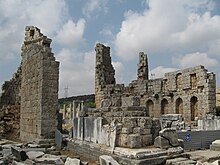History
In the twelfth century BC, there was a large wave of Greek migration from northern Anatolia to the Mediterranean coast. Many settled in the area immediately east of the area of modern-day Antalya, which came to be known as Pamphylia, meaning "land of all tribes". Four great cities eventually rose to prominence in Pamphylia: Perga, Sillyon, Aspendos and Side.Perga itself was founded in around 1000 BC and is nearly 20 kilometres (12 mi) inland. It was sited inland as a defensive measure in order to avoid the pirate bands that terrorized this stretch of the Mediterranean.
In 546 BC, the Achaemenid Persians defeated the local powers and gained control of the region. Two hundred years later, in 333 BC, the armies of Alexander the Great arrived in Perga during his war of conquest against the Persians. The citizens of Perga sent out guides to lead his army into the city.
Alexander's was followed by the diadoch empire of the Seleucids, under whom Perga's most celebrated ancient inhabitant, the mathematician Apollonius (c.262 BC – c.190 BC), lived and worked. Apollonius was a pupil of Archimedes and wrote a series of eight books describing a family of curves known as conic sections, comprising the circle, ellipse, parabola and hyperbola.
Roman rule began in 188 BC, and most of the surviving ruins today date from this period. After the collapse of the Roman Empire, Perga remained inhabited until Seljuk times, before being gradually abandoned.
Remains
Tour guides tell the story that Perga is the birthplace of beer, allegedly discovered by accident; but recent finds of Pharaonic beer predate the city by far.
Ecclesiastical history
St. Paul the Apostle and his companion St. Barnabas, twice visited Perga as recorded in the biblical book, the Acts of the Apostles,[2] during their first missionary journey, where they "preached the word"[3] before heading for and sailing from Attalia (modern-day Antalya city), 15 kilometres (9.3 mi) to the southwest, to Antioch.Perge remained a Roman Catholic titular metropolitan see in the former Roman province of Pamphylia Secunda. Paul and Barnabas came to Perge during their first missionary journey, but probably stayed there only a short time, and do not seem to have preached there;[4] it was there that John Mark left Paul to return to Jerusalem. On his return from Pisidia Paul preached at Perge.[5]
The Greek Notitiae episcopatuum mentions the city as metropolis of Pamphylia Secunda until the thirteenth century. Le Quien[6] gives 11 bishops: Epidaurus, present at the Council of Ancyra (modern Ankara) in 312; Callicles at the First Council of Nicæa in 325; Berenianus, at Constantinople (426); Epiphanius at the Second Council of Ephesus (449), at the First Council of Chalcedon (451), and signer of the letter from the bishops of the province to Emperor Leo (458); Hilarianus, at the First Council of Constantinople in 536; Eulogius, at the Second Council of Constantinople in 553; Apergius, condemned as a Monothelite at the Third Council of Constantinople in 680; John, at the Trullan council in 692; Sisinnius Pastillas about 754, Constans, at the Council of Nicæa (787); John, at the Fourth Council of Constantinople in 869-70.

